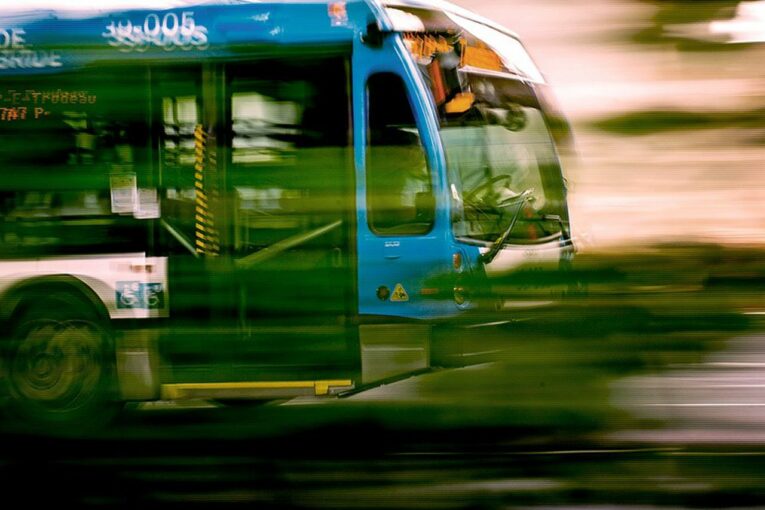
[ad_1]
MONTREAL – In this atypical back-to-school September, public transportation networks in the Montreal region hope to regain their customers of pre-pandemic times. Transit services are almost fully restored, although the sanitary measures put in place in the past year remain. While cars clog the roads as before, barely half of transit users have returned to trains, buses and the metro. Is this the impact of working from home? Greater Montreal’s four public transport networks take stock of the situation.
***
Société de transport de Montréal (STM): Teleworking, a deep and lasting impact
The Société de transport de Montréal (STM) hopes to regain “between 50 and 75 per cent” of pre-pandemic ridership on its bus and metro networks, said Luc Tremblay, director general of the public transportation network, cautiously setting a wide target range.
Back-to-school “is like a transition,” he said. Students returning to public transit account for only 14 per cent of the STM’s overall ridership. It is the return of workers, who make up 64 per cent of its clientele, that is uncertain.
“The impact of working from home, at this point in time, is completely unknown,“ Tremblay said. “We have to consider that teleworking is here to stay. The paradigm has taken hold. It has been thoroughly proven that employees can be very productive at home, while also reducing their commute.”
Since March 2020, 3,000 of the STM’s 11,000 employees have been working from home, he said. Only 30 per cent of the company’s employees live in Montreal. “Most of them spend between two and three hours each day travelling to and from work. If we offer them a hybrid schedule, two days at the office, three days at home, what do you think they are going to say? It will have a lasting impact on their quality of life.“
“Transportation is linked to people’s behaviour. If people’s behaviour changes, we feel it, and we will have to adjust. For us … the lasting effect of the pandemic and working from home may be a push to provide different services at different times,“ he added.
Before the pandemic, “we would go out in the morning at 5 a.m. and come back to the garage at 9 a.m., setting out again at 3 p.m. and returning at 7 p.m.“ Tremblay said. ”In the future, peak periods may be less extreme, but we will have to put more buses on the road between 10 a.m. and 3 p.m. to adjust to new demand.“
The effects will stick around long after the pandemic is over. “We just don’t know by how much,” Tremblay said.
Current numbers:
Level of service planned for the start of the school year: 100 per cent of services offered before the pandemic
Current ridership: 45 per cent of pre-pandemic numbers
On buses: 55 per cent of ridership in 2019
In the metro: 45 per cent of ridership in 2019
In paratransit: 45 per cent of ridership in 2019
***
Réseau de transport de Longueuil (RTL) : A network in transition
2020 started off with a bang for the Réseau de transport de Longueuil (RTL), with ridership increases of nearly four per cent in January and February. It was also an important year for the transportation network’s transition to its new mandate: to supply the three South Shore stations for the future Réseau express métropolitain (REM) light rail network, scheduled to open in the spring of 2022.
The cancellation of dozens of bus lines on the REM route will put an end to 30 years of direct RTL services to downtown Montreal via the Champlain Bridge. In the winter of 2020, nearly 25,000 people crossed the St. Lawrence River by this bridge every day. The service made up between 25 per cent and 30 per cent of the RTL’s total ridership. It’s also where numbers collapsed in the first lockdown in March 2020.
“With offices closed and a deserted city centre, almost all lines to the downtown terminus station have been cancelled. It’s hard to believe, but we haven’t had any complaints,” said Michel Veilleux, general manager of the Longueuil network.
And demand is still low. In the first six months of 2021, trips made by the RTL to Montreal decreased by 84 per cent, compared to the same period in 2019 (last comparable year).
The return of students – who made up nearly a third of the network’s total ridership before the pandemic – will fill the buses a little. The RTL says it will continuously monitor bus traffic to be able to react quickly to any changes in service requests, which have never been more difficult to predict.
“With these changes in behaviour, intense real estate development on the South Shore and new customer access points to be served, it will take a bit of luck to win back our users and gain new ones,“ Veilleux said.
Current numbers:
Level of service planned for the start of the school year: 86 per cent of services offered before the pandemic
Current ridership: 47 per cent of pre-pandemic numbers
***
Société de transport de Laval (STL): Less affected by teleworking
“Throughout the pandemic, we have always maintained a slightly higher ridership than other public transportation companies,” said Pierre Lavigueur, director of development and innovation at Laval’s public transportation network. “It’s not just because we’re good. It’s because we are far from the city centre.”
Even though its buses transport thousands of Laval residents every day, the STL has no direct connection to the city centre, the first area deserted by workers at the start of the pandemic.
“Our clientele are primarily students and the industrial parks in Laval. We are less dependent on trips to the city centre. We were therefore a little less impacted by teleworking,” said Christine Gauvreau, STL’s senior director of planning and development.
In early August, she said, ridership on the network was at 55 per cent of that of 2019. It is the highest rate in Greater Montreal. As in Longueuil, the pandemic highlighted the importance of local trips, which have shown an upward trend in recent years. “Some Saturdays and Sundays we reached almost 65 per cent” of 2019 numbers, Gauvreau said.
For the start of the school year, the STL services are at 97 per cent of those offered in the fall of 2019, despite the uncertainty around demand from office workers.
“It’s why we have to maintain a high level of service,” Lavigueur said. “Reduced service would mean fewer buses, more passengers per bus” and close contact that riders may not yet be ready for after 18 months of physical distancing.
“We are not going to oppose teleworking,” he added “because the best solution to reduce greenhouse gases is not to travel. But if you must travel, we offer a serious and more environmentally friendly alternative.”
Current numbers:
Level of service planned for the start of the school year: 97 per cent of services offered before the pandemic
Current ridership: 55 per cent of pre-pandemic numbers
***
exo buses and commuter trains: Falling forecasts
The COVID-19 pandemic and the radical transformation in travel habits due to teleworking have hurt no public transportation network as much as exo. And it’s far from over.
At the start of the summer, Sylvain Yelle, exo’s managing director, said he hoped for a gradual return in train ridership to 60 per cent of pre-pandemic levels, with buses at 75 per cent.
But “the arrival of the Delta variant and the start of the fourth wave of the COVID-19 pandemic are forcing us to revise our forecasts downwards for the fall of 2021,” he said. exo now hopes to recover 41 per cent of pre-pandemic ridership on its commuter trains in the fall (instead of 60 per cent) and 55 per cent of riders on its bus services (instead of 75 per cent).
In the time since exo updated its forecasts, the Quebec government announced it was postponing the return of its employees to offices until October (or January in some cases), and public health authorities recommended that private employers do the same.
As long as downtown Montreal stays shut down, the suburban trains and buses that lead to it, especially from the South Shore, will not be filled. More than 70 per cent of train customers are office workers, and most commuter bus users are too. Starting in the fall, bus lines serving train stations will have added departures “to facilitate travel for users who will be called upon to travel outside peak times.”
Almost all commuter train departures will be offered despite low ridership. Trains will be shorter, with added train cars during rush hours if necessary. It is one way to optimize service “while respecting the budgetary framework set by the Regional Metropolitan Transport Authority,” the transportation network said.
Current numbers:
Level of service planned for the start of the school year: 90 per cent of services offered before the pandemic
Current ridership compared to pre-pandemic numbers (2019):
Northern bus: 60 per cent
Southern bus: 32 per cent
Suburban trains: 15 per cent
Paratransit: 100 per cent
[ad_2]
You can read more of the news on source



